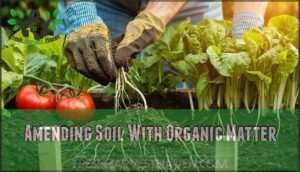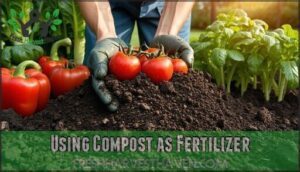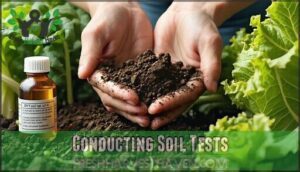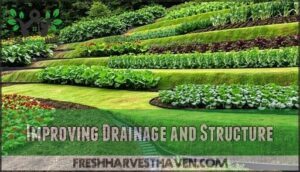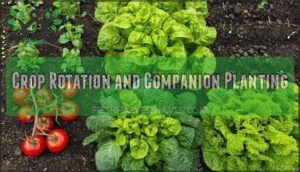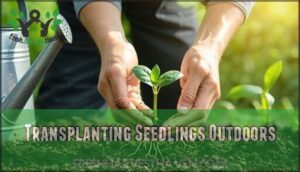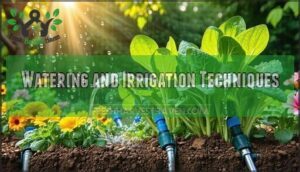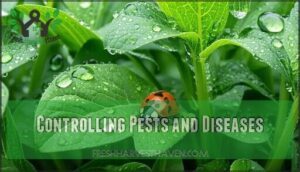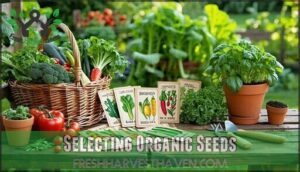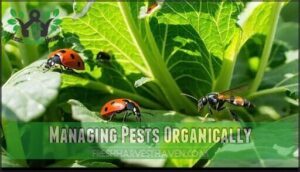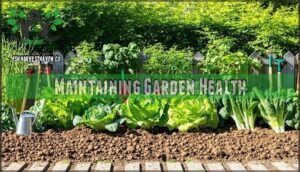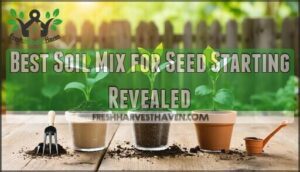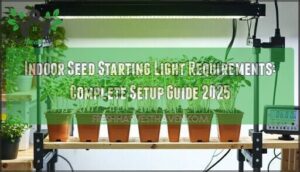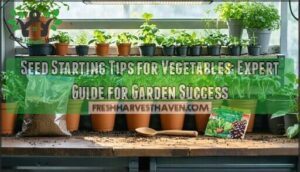This site is supported by our readers. We may earn a commission, at no cost to you, if you purchase through links.
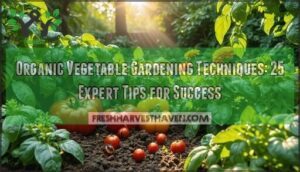 You’ll transform your backyard into a thriving organic paradise by mastering a few key organic vegetable gardening techniques.
You’ll transform your backyard into a thriving organic paradise by mastering a few key organic vegetable gardening techniques.
Start with healthy soil by adding compost and organic matter, then choose companion plants that naturally repel pests while supporting each other’s growth.
Water deeply but less frequently to encourage strong root systems, and use mulch to retain moisture and suppress weeds.
Practice crop rotation to prevent disease buildup, and encourage beneficial insects like ladybugs and lacewings to handle pest control naturally.
These time-tested methods work together like a well-orchestrated symphony, creating an ecosystem where your vegetables can flourish without synthetic chemicals, using natural methods.
Table Of Contents
- Key Takeaways
- Soil Preparation Techniques
- Organic Gardening Methods
- Selecting Organic Seeds
- Managing Pests Organically
- Maintaining Garden Health
- Frequently Asked Questions (FAQs)
- How to have an organic vegetable garden?
- What is a disadvantage of organic gardening?
- What is the easiest crop to grow organically?
- What is the best organic matter for vegetable gardens?
- What is organic vegetable gardening?
- How to start an organic vegetable garden?
- How do you grow an organic garden?
- How do you produce vegetables organically?
- How to grow a healthy organic vegetable garden?
- How do you start a vegetable garden?
- Conclusion
Key Takeaways
- Build healthy soil first – You’ll create the foundation for success by adding compost and organic matter to improve soil structure, drainage, and nutrient content before planting anything.
- Practice companion planting and crop rotation – You’ll naturally control pests and prevent disease buildup by pairing beneficial plants together and rotating crop families each season.
- Use natural pest control methods – You’ll protect your vegetables without chemicals by encouraging beneficial insects, applying organic sprays, and using physical barriers like row covers.
- Water efficiently with mulching – You’ll conserve water and suppress weeds by watering deeply but less frequently and applying 2-3 inches of organic mulch around your plants.
Soil Preparation Techniques
Success in organic vegetable gardening starts with healthy soil that serves as the foundation for thriving plants.
You’ll need to focus on building rich, well-structured soil through organic amendments, proper testing, and strategic improvements that create the ideal growing environment for your vegetables, which is crucial for thriving plants.
Amending Soil With Organic Matter
Your garden’s success depends on enriching soil with organic matter before planting.
This foundation creates the perfect environment for vegetable growth and healthy soil microbes.
Transform your soil with these proven methods:
Transform your garden beds into thriving ecosystems with these simple amendments that feed both plants and soil.
- Compost Amendments – Mix finished compost into beds for improved structure and slow-release nutrients
- Manure Application – Work aged manure into soil for nitrogen-rich organic fertilizer
- Green Manures – Plant cover crops like clover to naturally boost soil fertility
- Vermicomposting – Add worm castings for premium soil conditioning
These composting techniques build soil health while supporting your organic gardening goals. Each amendment feeds beneficial microorganisms that make nutrients available to your vegetable garden throughout the growing season.
Creating a Compost Pile
You’ll create nutrient-rich black gold by layering compost ingredients—brown materials like dried leaves with green kitchen scraps.
Turning frequency matters: flip your pile weekly to boost oxygen and speed decomposition.
Monitor pile moisture like a wrung-out sponge and compost temperature reaching 130-160°F.
Maintaining proper temperatures requires accurate temperature monitoring.
Understanding decomposition stages helps you recognize when your homemade organic fertilizer is ready for your vegetable garden.
Using Compost as Fertilizer
Your homemade compost transforms kitchen scraps and yard waste into nutrient-rich organic matter that’ll supercharge your vegetable garden.
Your kitchen scraps become garden gold—transforming waste into the nutrient powerhouse your vegetables crave.
This natural fertilizer releases carbon compounds slowly, feeding soil microorganisms while improving drainage and water retention. Unlike synthetic options, compost provides balanced nutrition through plant-based and animal-based fertilizers that won’t burn delicate roots.
Here’s how to maximize compost benefits:
- Apply 2-3 inches around established plants as mulch, keeping it away from stems to prevent rot
- Mix into planting holes at a 1:1 ratio with native soil for transplant success
- Brew compost teas by steeping finished compost in water for 24-48 hours, creating liquid gold
Different compost types offer varying nutrients – kitchen scraps provide nitrogen while leaves add carbon. You can find various compost fertilizer products to enhance your garden.
Proper compost application timing matters most during spring planting and fall soil preparation. Your organic gardening techniques improve dramatically when you understand that compost ingredients determine final nutrient content.
Conducting Soil Tests
Most gardeners benefit from annual soil tests to reveal their garden’s potential.
DIY kits provide quick pH and basic nutrient readings, while professional labs deliver detailed analysis of nutrient deficiencies and carbon compounds.
Testing frequency depends on your soil quality – new gardens need baseline tests, established plots require annual checks.
Interpreting results guides your organic gardening techniques, revealing which natural fertilizers or plant-based fertilizers your vegetables actually need for ideal growth.
Proper leveling ensures garden beds have drainage.
Improving Drainage and Structure
When drainage problems plague your garden, you’re fighting an uphill battle against soggy soil and stunted growth.
Poor structure suffocates roots and blocks essential nutrients from reaching your plants.
Transform your soil with these proven solutions:
- Install French drains to redirect excess water away from planting areas
- Build raised beds 6-8 inches high for improved drainage and root development
- Add organic soil amendments like compost and aged manure to create air pockets
- Use terracing slopes to prevent erosion while managing water flow effectively
- Plant cover cropping during off-seasons to naturally improve soil structure.
These watering methods and garden maintenance practices support healthy vegetable cultivation while providing natural weed control for long-term success.
Organic Gardening Methods
Once you’ve prepared your soil, implementing proven organic methods transforms your garden into a thriving ecosystem that works with nature rather than against it.
These fundamental techniques will help you grow healthy vegetables while building soil fertility and managing pests naturally.
Crop Rotation and Companion Planting
Strategic crop rotation and companion planting transform your garden into a self-sustaining ecosystem.
These organic farming techniques boost yields while reducing pest pressure naturally.
Rotation Benefits: Alternating plant families prevents soil depletion and disease buildup.
Companion Combinations like basil with tomatoes enhance flavor and deter pests.
Pest Reduction occurs when marigolds repel harmful insects.
Yield Improvement happens through complementary plantings.
Nitrogen Fixation from legumes enriches soil for subsequent crops.
Master these garden planning strategies:
- Rotate heavy feeders with nitrogen-fixing legumes – soil gets natural enrichment
- Plant aromatic herbs near vegetables – natural pest deterrence works continuously
- Follow root crops with leafy greens – different depths prevent nutrient competition
- Pair complementary species strategically – mutual benefits maximize garden potential
- Plan three-year rotation cycles – soil health improves through systematic vegetable cultivation
Transplanting Seedlings Outdoors
Before moving your seedlings outdoors, hardening off is essential for their survival in harsh conditions. Start this process seven days before transplanting by gradually exposing seedlings to outdoor elements. Begin with two hours of morning sunlight, then increase exposure daily.
Check weather considerations – avoid transplanting during extreme temperatures or strong winds. When ready, dig holes matching planting depth requirements, typically to the first set of true leaves. Handle seedlings gently to minimize root disturbance.
Establish a consistent watering schedule immediately after transplanting. Consider companion planting during your garden planning to maximize space for seasonal vegetables.
Apply plant-based fertilizers to support organic farming practices and guarantee strong establishment.
Using Mulch for Weed Control
With proper mulching techniques, you’ll transform your garden maintenance routine and create sustainable agriculture practices that support herbicide-free gardening.
Apply a 2-3 inch layer of organic mulch around your plants, keeping it several inches from stems to prevent disease and pest issues. Choose from various mulch types like straw, compost, or shredded bark for maximum weed prevention and soil benefits. Different materials offer varying decomposition rates – straw breaks down quickly, enriching soil, while bark provides longer-lasting coverage.
Mulching also helps with soil temperature regulation by blocking sunlight.
Mulching serves as natural pest control by creating barriers that discourage harmful insects while supporting beneficial soil organisms. This approach produces chemical-free produce while reducing watering needs.
- Break free from endless weeding – mulch gives you back your weekends
- Watch weeds surrender to your organic mulching strategy
- Feel the satisfaction of a pristine, weed-free garden bed
- Enjoy peace of mind knowing your soil stays moist and protected
- Experience the joy of effortless garden maintenance all season long
Watering and Irrigation Techniques
Morning watering gives your plants the best start each day. Water conservation becomes simple when you focus on efficient techniques like deep watering 2-3 times weekly rather than daily sprinkles.
Drip irrigation delivers water directly to roots, cutting waste by 50% compared to overhead sprinklers. For purchasing options, you can explore a complete irrigation setup. Soaker hoses work similarly, keeping leaves dry to prevent disease while maintaining consistent soil moisture.
| Method | Water Usage | Disease Risk |
|---|---|---|
| Drip irrigation | Low | Minimal |
| Soaker hoses | Medium | Low |
| Sprinklers | High | Moderate |
Check soil moisture by inserting your finger two inches deep. Sandy soils need more frequent watering, while clay holds moisture longer. Watering frequency depends on your soil type, weather, and plant needs. Smart scheduling based on these factors maximizes ecosystem health while supporting your organic garden’s success.
Controlling Pests and Diseases
Your garden’s health depends on spotting trouble early.
Check plants weekly for pest identification signs like chewed leaves or discolored spots.
Beneficial predators like ladybugs and lacewings control aphids naturally.
Organic sprays made from soap or natural fungicides like baking soda prevent disease prevention issues.
Beneficial insects thrive when you avoid organic pesticides unless absolutely necessary.
This plant-based solution approach supports organic farming while producing chemical-free produce.
Selecting Organic Seeds
Selecting the right seeds forms the foundation of your organic vegetable garden’s success.
You’ll want to choose varieties that match your climate, soil conditions, and growing experience while prioritizing certified organic options that haven’t been treated with synthetic chemicals, focusing on complete concepts to ensure the best results.
Choosing Easy to Grow Crops
Success starts with choosing beginner vegetables that practically grow themselves. Lettuce, radishes, and beans offer quick harvests within weeks, while tomatoes and peppers provide abundant yields throughout the season.
- Low-maintenance herbs like basil and parsley thrive in container gardening setups
- Heirloom seeds from organic farming sources guarantee chemical-free organic produce
- Consider climate suitability when selecting varieties for your growing zone
- Plant-based fertilizers support healthy growth in organic seeds and transplants
Selecting Pest Resistant Varieties
The right varieties act like your garden’s built-in security system against pests and diseases.
Disease resistance becomes your first line of defense, reducing pesticide needs by up to 50% while boosting yields substantially. Local adaptation matters too—choose cultivars proven in your region’s conditions.
- Tomato powerhouses like ‘Defiant’ and ‘Iron Lady’ resist late blight and early blight naturally
- Cucumber champions such as ‘Marketmore 76’ fend off powdery mildew and mosaic virus
- Bean varieties like ‘Provider’ bush beans resist common mosaic virus and bacterial spots
Variety trials help you discover which genetic diversity works best in your space. Heirloom options often carry natural resistance traits developed over generations, supporting chemicalfree agriculture.
To further enhance your garden’s defenses, consider interplanting for pest control. This plantbased solutions approach creates a sustainable ecosystem while maintaining herbicidefree gardening practices.
Prioritizing Organic Seeds and Plants
When choosing organic seeds and plants, you’re investing in chemical-free agriculture that supports your garden’s long-term health.
Organic certification guarantees freedom from synthetic pesticides and GMOs, while heirloom varieties preserve genetic diversity.
| Seed Type | Best For |
|---|---|
| Heirloom vs Hybrid | Genetic diversity, seed saving |
| Disease Resistance | Reduced chemical interventions |
| Organic Produce | Chemical-free harvests |
| Plant-based Solutions | Sustainable growing methods |
Prioritize reputable sources offering certified organic seeds and plants.
Proper seed starting mix and plant acclimation techniques maximize your investment in organic farming practices.
Understanding Seed Labels and Certifications
Seed Label Decoding transforms confusing packages into clear gardening roadmaps.
Look for the USDA organic seal and organic certification marks that guarantee authentic organic farming practices.
Check germination rate meaning percentages—80% or higher guarantees reliable sprouting.
Heirloom seed value lies in their proven genetics and seed saving legality for future harvests.
Quality organic food labeling includes organic certification types from trusted agencies, giving you confidence in your organic produce investment.
Saving Seeds for Future Use
Once you’ve mastered reading labels and certifications, you’ll want to become your own seed supplier. Saving seeds from your best plants creates a self-sustaining cycle that improves your garden year after year while preserving genetic diversity.
Open-pollinated varieties work best for seed saving since they’ll produce plants true to type.
Here’s your roadmap to success:
- Perfect Timing: Harvest seeds when fully mature – let tomatoes get overripe, peppers turn completely red, and beans dry completely on the plant before collecting.
- Proper Processing: Clean seeds thoroughly by removing all fruit pulp and plant debris, then spread them on screens or paper plates to air-dry for 1-2 weeks.
- Smart Storage: Place dried seeds in labeled envelopes inside airtight containers with silica gel packets, storing in cool, dark locations to maintain seed viability.
- Annual Testing: Check germination rates by sprouting 10 seeds on damp paper towels – 70% success indicates good viability for sustainable agriculture practices.
Managing Pests Organically
Managing pests organically requires understanding what you’re dealing with and using natural methods that protect your plants without harming beneficial insects.
You’ll discover how to identify common garden threats and implement effective, earth-friendly solutions that keep your vegetable garden thriving, using methods that are also organic.
Identifying Common Pests and Diseases
When spotting trouble early, you’ll save your garden from major headaches.
Pest identification starts with daily crop monitoring – check for aphids on tender shoots, caterpillars munching leaves, or spider mites creating fine webbing.
Disease prevention means recognizing fungal spots, bacterial wilts, and viral mosaics before they spread.
This vigilant approach supports sustainable agriculture practices and guarantees your chemicalfree produce stays healthy naturally.
Employing sticky traps can also help identify pests.
Using Physical Barriers for Pest Control
Physical barriers work like invisible bodyguards for your plants, stopping pests before they strike.
These barrier materials create protective zones without disrupting your chemical-free gardening approach.
Row covers made from lightweight fabric shield seedlings from flying insects while letting sunlight and water through.
Plant sleeves protect individual stems from cutworms and other crawling pests.
Copper tape around raised beds creates an electric fence effect that slugs won’t cross.
Trap cropping uses sacrificial plants to lure pests away from your main crops.
You’ll plant nasturtiums to attract aphids or radishes to draw flea beetles, keeping them busy while your vegetables grow undisturbed.
These organic pesticide alternatives support your plant-based gardening goals:
- Floating row covers – Remove during flowering for pollination
- Cutworm collars – Make from toilet paper tubes or cardboard
- Sticky traps – Replace yellow cards weekly for best results
- Hardware cloth – Protects against rabbits and larger pests
- Mulch barriers – Create dry zones slugs avoid crossing.
These sustainable ecosystem strategies prove that organic farming impact extends beyond soil health to smart pest prevention.
Making Organic Pesticides at Home
Creating DIY pesticide recipes from common kitchen ingredients offers effective, chemical-free gardening solutions.
Garlic-based sprays reduce aphid populations by 80%, while chili pepper extracts show 90% effectiveness against soft-bodied insects.
Soap solutions at 2% concentration disrupt pest cell membranes.
These plant-based ingredients provide pest-specific solutions as powerful organic pesticide alternatives.
Proper homemade pesticide storage shouldn’t exceed one week, and safe application methods include early morning spraying to protect beneficial insects while maximizing organic pesticide effectiveness.
Using Neem Oil for Pest Control
Beyond disrupting insect feeding patterns, neem oil offers effective organic gardening solutions for common garden pests. This plant-based extract provides broad Effectiveness Spectrum against soft-bodied insects while supporting chemicalfree gardening techniques.
Neem Oil Uses include targeting:
- Aphids and whiteflies on leafy vegetables
- Spider mites on tomatoes and peppers
- Thrips damaging cucumber plants
- Scale insects affecting herb gardens
Mix one to two tablespoons per gallon of water with mild dish soap for proper Application Techniques. Safety Precautions require evening applications to prevent leaf burn. Organic pesticide effectiveness appears within three to seven days of consistent use, making it superior to many Alternative Options for sustainable pest management.
Encouraging Beneficial Insects
With strategic habitat creation, you’ll transform your garden into a beneficial insect paradise.
Plant insectary plants like yarrow, dill, and sweet alyssum alongside vegetables to attract ladybugs and parasitic wasps.
These attracting predators techniques naturally reduce pest populations while reducing pesticides in your organic gardening approach.
Add shallow water sources for complete ecosystem health improvement through chemical-free gardening techniques.
Maintaining Garden Health
A healthy organic garden thrives when you create the right conditions for both plants and beneficial organisms to flourish together.
By focusing on soil health, proper watering, and encouraging natural pest control, you’ll build a self-sustaining ecosystem that produces abundant harvests year after year.
Attracting Beneficial Insects
Your garden becomes a thriving ecosystem when you establish insectary plants and habitat creation zones that welcome natural predators.
Using companion planting with diverse flowers provides hunting grounds for ladybugs and lacewings.
While reduced pesticides protect these allies, using plant-based fertilizers supports natural fertilizer benefits through chemical-free gardening.
This approach creates ecosystem health improvement that demonstrates sustainable agriculture innovations working harmoniously together.
Creating a Pollinator Garden
Your pollinator garden becomes a powerhouse for organic gardening when you attract pollinators through thoughtful habitat creation.
Native plants serve as magnets for bees, butterflies, and beneficial insects while requiring minimal maintenance.
Strategic garden design places flowering clusters near vegetable beds, creating pollinator support that boosts yields naturally.
This sustainable ecosystem approach enhances your chemicalfree gardening efforts through increased cross-pollination.
Practicing Good Garden Sanitation
Clean gardens aren’t just pretty—they’re your first line of defense against devastating plant diseases that can wipe out entire harvests. Tool sanitation starts with wiping down pruners and shovels between plants using rubbing alcohol, preventing pathogen spread from diseased specimens to healthy ones. This simple step transforms your tools from disease vectors into protective allies for your organic gardening efforts.
Debris removal requires weekly attention to maintain chemical-free gardening standards. Consider these sustainable ecosystem practices:
- Remove fallen leaves immediately to eliminate overwintering disease spores
- Clear dead plant material before it becomes a breeding ground for harmful organisms
- Dispose of diseased plants in municipal waste, never your compost pile
- Rake up dropped fruits that attract pests and harbor bacterial infections
Proper waste disposal and compost management protect soil quality while supporting plant-based gardening principles. Disease prevention becomes second nature when you maintain these sanitation habits consistently throughout the growing season.
Effective Irrigation Techniques
Water mastery transforms ordinary gardens into thriving ecosystems.
Drip irrigation delivers water directly to roots, reducing waste by up to 60% compared to overhead sprinklers.
Soaker hoses provide consistent moisture distribution while minimizing evaporation losses.
| Irrigation Method | Water Efficiency | Best For | Setup Cost |
|---|---|---|---|
| Drip Systems | 90-95% efficient | Rows, containers | Moderate |
| Soaker Hoses | 80-85% efficient | Beds, borders | Low |
| Sprinklers | 60-70% efficient | Large areas | High |
| Hand Watering | 50-60% efficient | Small gardens | Minimal |
| Rain Barrels | 100% conservation | Supplemental use | Low |
Irrigation timing matters—water early morning to reduce evaporation by 30%.
Check soil moisture regularly by inserting your finger two inches deep.
Sandy soils need frequent, light watering while clay requires deeper, less frequent sessions.
These organic gardening and plant-based gardening practices support soil quality and groundwater conservation, essential for organic farming sustainability practices.
Monitoring and Maintaining Soil Health
Throughout your organic garden’s journey, soil health serves as the foundation for sustainable success.
Monitor soil pH annually using home test kits to maintain the ideal 6.0-7.0 range for maximum nutrient absorption.
Check these key indicators regularly:
- Water retention – Observe drainage patterns after rainfall to assess soil structure
- Compaction issues – Insert a screwdriver; it should penetrate easily through healthy soil
- Microbial life – Look for active earthworm populations and rich organic matter content
Test nutrient levels seasonally, supplementing with plant-based fertilizers or animal-based fertilizers as needed.
Healthy soil contains diverse carbon compounds that support organic farming sustainability through thriving microbial communities.
Frequently Asked Questions (FAQs)
How to have an organic vegetable garden?
Start with healthy soil using compost and organic matter. Plant companion crops, rotate families yearly, and use natural pest control like beneficial insects and organic sprays.
What is a disadvantage of organic gardening?
You’ll face higher labor costs since organic methods require more hands-on weeding, pest monitoring, and soil management compared to conventional gardening’s chemical shortcuts.
What is the easiest crop to grow organically?
Like planting seeds in fertile ground, lettuce becomes your garden’s gentle introduction to organic success.
You’ll find leafy greens thrive with minimal fuss, growing quickly in cool weather while naturally resisting most pests and diseases, which makes them a great choice for a beginner’s garden to experience success.
What is the best organic matter for vegetable gardens?
Compost stands out as the best organic matter for your vegetable garden. It improves soil structure, retains moisture, and feeds plants slowly with balanced nutrients throughout the growing season.
What is organic vegetable gardening?
Organic vegetable gardening means growing crops without synthetic pesticides, fertilizers, or GMOs.
You’ll use natural methods like composting, crop rotation, and beneficial insects to create healthy soil and manage pests naturally.
How to start an organic vegetable garden?
You’ll want to test your soil first, then choose a sunny location with good drainage.
Start with compost-rich soil, select easy vegetables like lettuce and tomatoes, and plan your garden layout carefully.
How do you grow an organic garden?
Start with healthy, well-draining soil enriched with compost and organic matter.
Choose certified organic seeds, practice crop rotation, use natural pest control methods.
Avoid synthetic fertilizers or pesticides throughout the growing season, and use natural pest control methods to maintain a healthy environment.
How do you produce vegetables organically?
While synthetic chemicals dominate modern agriculture, you’ll grow vegetables organically using natural methods like compost, crop rotation, and beneficial insects for pest control.
How to grow a healthy organic vegetable garden?
Build healthy soil with compost, rotate crops by family, use companion planting for pest control, and water consistently with mulching to retain moisture and suppress weeds.
How do you start a vegetable garden?
Choose your spot wisely, prepare the soil thoroughly, plan your layout carefully.
You’ll need a sunny location, quality soil amendments, and proper spacing.
Test soil pH, add compost, and select vegetables suited to your climate and growing season for success.
Conclusion
Growing your own organic vegetables becomes second nature when you master these organic vegetable gardening techniques.
Like a skilled conductor guiding an orchestra, you’ll orchestrate soil health, companion planting, and natural pest control into perfect harmony.
Your garden will reward your patience with abundant harvests, proving that working with nature beats fighting against it.
You’ve got the knowledge—now it’s time to get your hands dirty and watch your organic paradise flourish.

